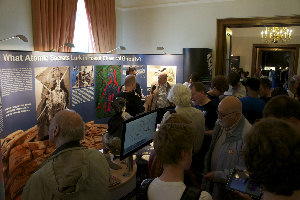A pigment of our imagination
05 Jul 2012
Tune in to Dr Phil Manning’s interview on BBC Radio 4’s Material World (5 July).

Phil, from the School of Earth, Atmospheric and Environmental Sciences, talked to Quentin Cooper about the University’s exhibit at the The Royal Society Summer Science Exhibition, which includes stunning colours captured from 120 million year old fossils using cutting edge technology. The research presentations by Manchester’s team of palaeontologists and geochemists are attracting throngs of fascinated visitors, including the Duke of York.
If you missed the original broadcast, you can listen to the programme at:
- BBC iPlayer: Material World (the interview begins halfway through)
The exhibit (Palimpsests, Palaeontology and Particle Physics) features rare fossils (including a 120 million year old bird) and chemical images of prehistoric life extracted from the sands of time by using the most powerful light sources in the universe. The light source at the Stanford Synchrotron shines brighter than a million suns.
The research is the closest scientists have come to putting a finger on the pulse of these amazing fossils, which includes birds, fish, dinosaurs and a host of other creatures more than 100 million years old.
Visitors to the exhibition will be able to see these ground-breaking images produced by the Manchester team who have worked at the Stanford Synchrotron Radiation Lightsource in California. Visitors to the exhibit will get a chance to see how a synchrotron works, with a scale model of the device
The exhibit, constructed by the University's Palaeontology Research Group, shows the results of a collision between particle physics and palaeontology by exploring what happens when scientists shed intense x-ray light on these very ancient fossil remains.
From the writings of Archimedes to prehistoric traces of soft tissues, and from the remains of Archaeopteryx to Confuciusornis, the scientists are unlocking fossilized chemical ghosts. What they learn will undoubtedly yield benefits to our understanding of Earth processes, from the past and present, but also the future.
Phil and Dr Roy Wogelius work with their team in collaboration with the Stanford Synchrotron Radiation Lightsource (SSRL) in the USA and the Diamond Synchrotron in the UK on analysing fossils using synchrotron radiation.
Phil said: “This is a splendid opportunity for the Manchester team to show the world our cutting-edge research.
“Our understanding of the biology and preservation of ancient life is being dramatically enhanced using the synchrotron-based imaging techniques. The research also clearly demonstrates the relevance of fossil research in the 21st century.
“By understanding the burial of past organic matter, we might better predict what happens when our own species buries waste in the ground for future generations to deal with”.
The scientists will be on hand at the exhibition which runs from 3 July to 8 July.
There’s an app and iBook to accompany the exhibit, both called 'Chemical Ghosts', which can be downloaded from the iTunes store for FREE! Sadly, these will only work on an iPad, but Phil describes them as “very, very cool!”
The app ends with an augmented reality 3D interactive on Confuciusornis sanctus. The 'trigger' for the 3D reconstruction can be downloaded from Phil’s blog:
